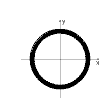Leaderboard
Popular Content
Showing content with the highest reputation on 08/21/19 in all areas
-
Then you would need evidence. What if it happened that way? What if it didn't? How do we decide. Oh yes: evidence. That is how science works. That is why it is not a scientific hypothesis: because it is impossible to come up with an objective test. What if the universe was created last Thursday but exactly as if it were 13.8 billions years old? Or because it just doesn't exist. A simulation does not require that it doesn't exist. If it is discovered, you will say, "ah but they decided to simulate it because ..." I predict that if the universe is simulated then tomorrow will be Thursday. I predict that if the universe is simulated then there is no visible colour beyond red. I predict that if the universe is simulated then black holes will have event horizons. We have already detected dark matter. But even so, simulation does not require that it does or doesn't exist. If the nature of dark matter is discovered, you will say, "ah but they decided to simulate it because ..." And this highlights the complete failure of the idea as an explanatory principle. Can it answer these questions: Why does this "setting" exist? (Because the Simulators felt like it) Why does the setting have this value? (Because the Simulators felt like it) No. It can't. Therefore it is not a scientific explanation. Even in a simulated universe, the scientific answer to "what is dark matter?" is "we don't know (yet). But we do know a lot about it and can build models and test them against what we observe." All your hypothesis can do, for any observation, is say "well, it is what it is because that is what it is." Again, absolutely nothing to do with simulation. A simulation could have aliens around every star. Or one in a million stars. O just one star in each gravity. Or just here on Earth. But so could an entirely natural universe. None of these are predictions of simulation. They are guesses. They are non sequiturs. There is no logical connection between the premise (simulation) and the conclusion. Just sticking the word "because" in there does not make it a logical argument. Apparently not.2 points
-
It's pretty simple, really. Can you think of a way to show something is false? Then it's falsifiable. But that's a great example. Finding a three-eyed swan is EXACTLY what would show "all swans have two eyes" to be a false statement. As a counter example, arguing that the Christian God exists is NOT falsifiable. Being unobservable, there's no way to perform adequate tests. There's no way to form a prediction based on observed behavior. Almost by definition, this god isn't going to show itself because that would destroy the reason behind the faith of its followers. Why is it nonsense? A single black swan is enough to disprove a statement like "all swans are white". But if I say "all swans are black or white", I can't prove that, not even if I check every living swan. I'd have to check every swan there ever was, or ever will be, and I'd have to be sure swans didn't live on any other planet in the universe as well. This is the basis for theory, the idea that we can only accumulate evidence in support rather than "proving" an idea. It's what keeps us searching for the most supported explanations, rather than answers we decide on and never go back to check.2 points
-
One of those engineering problems swansont referred to is how much water you can expect to get from a given surface area. (keep in mind, the following is only approximations but will demonstrate the scale we are talking about) A good solar distiller will give you about a gallon per day per square meter of surface area. Compare that to a distilling unit on an aircraft carrier that produces about 100,000 gallons/day using waste steam from the propulsion system in a unit that measures about 3.5 meters square by 5 meters high. The comparable solar unit would have to cover around 10 hectares and 100,000 gallons is only enough for about 500 households. Just one small city of 100,000 households would require 20,000 hectares of surface area. For comparison, the state of Rhode Island has about 400,000 households on around 300,000 hectares of land so the scale is not impossible, just very large. It seems doubtful to me that people will tolerate filling the oceans with that many distillers, though (look at how much opposition offshore wind farms got).2 points
-
It is a scientific statement, which (as you have said) has been falsified. In this terminology, "scientific" does not mean "confirmed". It's approximately equivalent to saying that a sentence is grammatically correct - the content may be true or false, but it satisfies certain rules about the sentence itself.1 point
-
The fact that you can count swan’s eyes is what makes it falsifiable. As it is impossible to check every Sean that ever lived or will live, all you can do is hope to find a swan with one or three eyes to disprove the hypothesis. Says the guy who doesn’t even know the difference between “falsify” and “falsifiable”.1 point
-
This is where your mistake lies. False, falsify, and falsifiable are three different concepts in science. All swans have two eyes is a false statement (I found a picture of a one-eyed swan). The picture falsified the statement "all swans have two eyes". The fact that finding swans with more or less than two eyes would make the statement "all swans have two eyes" false means the statement is falsifiable. All swans have two eyes is a statement that can be checked to see if it's false (making it falsifiable), but we can't do any checks to be certain it's true.1 point
-
For someone banging on about clarity etc, I’m rather surprised you haven’t provided a reference. I agree that the first bit of text you quote appears pretty bad. But as I don’t know where it is from, I can’t say much more. That is a hypothesis not a theory. It is falsifiable because we can specify ways of testing it. As it happens, these show that the hypothesis is false. Which it is why it is not a theory. You seem to confusing “falsified” with “falsifiable” The idea here is that you only need one example to disprove something (eg your room without a green unicorn) but it is much harder to prove something. Let’s say you have looked in every room in your house and, yes, there is a green unicorn there (obviously, this is just to explain the point). Then you check every room in every building in your town. Yep, the hypothesis still holds. You check every room in your country and then on the planet. Still no rooms without green unicorns. But by now, thousands of new buildings have gone up; they all need to be checked. And can you be certain that there weren’t some secret or hidden rooms you missed. And what about buildings on other planets (if they exist). It is usually impossible or impractical to test something exhaustively. So science more often relies on finding a counter-example, rather than trying to confirm every possible case. Good. I think you need to go and chill out1 point
-
ST and multiverse theories are attempts to solve problems of the day. Simulated reality solves nothing at this point in time. Simulated reality implies a reality outside of our own and god-like consciousness to create/control it. It's essentially a religious concept with modern details..1 point
-
Look in every physics textbook or for example the barycentre for the Earth Sun system. The Centre of mass is off centre of the sun due to the gravitational force of attraction of other planets such as Jupiter If you wish confirmation study Kepler's laws. The centre of mass is always the vectoral sum of forces. From your own link Choose a reference point R in the volume and compute the resultant forceand torque at this point, what do you think a resultant force is ?1 point
-
Actually there is little evidence that biotin improves hair growth, unless a person has biotin deficiency. Various forms of hair loss and skin conditions are associated with biotin deficiency and for the most part the cause is that carboxylases require biotin as a cofactor. I.e. hair loss and other conditions are the result of certain carboxylases not functioning any more. Otoh, there is little to no evidence that in patients with sufficient biotin intake will improve hair growth.1 point
-
Vinegar is usually a mixture of water and between 4 and 5% acetic acid. This versatile acid can mix with water, oil, alcohol and almost any other kind of liquid -- even gasoline -- reaching places that other cleaning products can't. When dissolved in water, acetic acid breaks into two components, the hydrogen and the remainder of the molecule, called the acetate. The hydrogen will try to bond to any molecule that it encounters, acting like a third wheel that weakens the molecule's structure. These hydrogens are great at cleaning stains made from alkali substances, like soap, urine, and limestone. The acetate component has an extra electron that hangs off the molecule. The electron acts as a magnet to other atoms, especially metals, to make new molecules. For example, the acetate reacts with molecules in rust and grime and changes their makeup so the water can dissolve them. Acetic acid also gets rid of odors by killing off the bacteria and fungi that cause them. Its acidic nature destroys the cell structure of bacteria, and it stops fungi from turning sugar into energy. https://www.networx.com/article/the-science-of-vinegar So not by magic, no, but actually there doesn’t seem to be any hard evidence about its ability to remove residue due to pesticides.1 point
-
Fire! Provides warmth and sterilizes food before consuming. Also, Indian tribes in the USA used fire for communication...they sent smoke rings into the air above (by flapping a piece of cloth or canvas over the fire).1 point
-
-1 points
-
For a brick, the unequivocal answer is NO! [math]{a_{c1}} = \frac{{\left[ {{m_1}{{\ddot r}_1}} \right]}}{{{m_1}}} = {{\ddot r}_1} = 0[/math] if [math]{{\vec F}^e} = 0[/math] For the CM system of bodies, the answer is YES! Acceleration of the Center of Mass is not a function of "external force." [math]{a_c} = \frac{{{d^2}{R_c}}}{{d{t^2}}} = \frac{{\sum {{m_i}{{\ddot r}_i}} }}{{\sum {{m_i}} }} + \frac{{\sum {{{\dot m}_i}{{\dot r}_i}} }}{{\sum {{m_i}} }} = ?[/math] if [math]{{\vec F}^e} = 0[/math] The acceleration of the CM of the system of bodies is the result of both external and internal forces. But the most interesting is another! The CM of a system of bodies can change without acceleration at all! You talk about CM, having in your head the concepts of "force", "acceleration", "velocity" [math]{{\vec R}_c}(t) = {{\vec R}_c}(0) + {{\vec V}_c}(t)t + \frac{1}{2}\frac{{{{\vec F}^e}}}{M}{t^2}[/math] But the CM "moves" like this: [math]{{\vec R}_c}(t) = \frac{{\sum {{m_i}(t){r_i}(t)} }}{{\sum {{m_i}} (t)}}[/math] The CM cannot move! CM is not a material object! A CM can only CHANGE how the result of a function of 2 (two) variables changes. I also have the right to ask you questions. Do you see the CM of this system? Do you see how he moves? === The Varipend task is not mathematically complicated and has a very accessible explanation from a physical point of view, which does not go beyond the school textbook. but this task is extremely difficult in terms of psychology. Therefore, I must ask you questions so that you LEARN to answer them YOURSELF.-1 points
-
Oh?! "Force" = "change in momentum" [math]\vec F = \frac{{{\rm{d}}\vec p}}{{{\rm{d}}t}} = \frac{{{\rm{d}}\left( {m\vec v} \right)}}{{{\rm{d}}t}}[/math] This is Physics. The science is ... Bad answer. The response of the layman. I repeat again. Watch and read carefully. Material Point System: The total momentum of this point system is defined as follows: [math]\vec P = \sum {{{\vec p}_i}} = \sum {{m_i}{v_i}} = {m_1}{{\vec v}_1} + {m_2}{{\vec v}_2} + {m_3}{{\vec v}_3} + ... + {m_i}{{\vec v}_i}[/math] If all these points would have the same speed, then this speed could be taken out of the sign of the sum, and sum the mass: And it would turn out like this: [math] \ vec P = M {\ vec V_c} [/math] In order for the speeds of all points of the system to become equal, all these points need to be simply connected! Connect inelastically! [math]{m_1}{{\vec v}_1} + {m_2}{{\vec v}_2} + {m_3}{{\vec v}_3} + ... + {m_i}{{\vec v}_i} \to Boom!!! \to ({m_1} + {m_2} + {m_3} + ... + {m_i}){V_c} = M{V_c}[/math] Actually, what you schoolchildren only know how to do! .... But here is the misfortune in this "simple" task .... As the author of this task, I came up with an inelastic connection of system components according to a special law. Like this: And in the total momentum for this system, the following regularity was determined: [math]{m_1}{{\vec v}_1} + {m_2}{{\vec v}_2} + {m_3}{{\vec v}_3} + ... + {m_n}{{\vec v}_n} = ({m_{i1}} + {m_{i2}} + {m_{i3}} + ... + {m_{in}}){{\vec V}_{ic}} + ({m_{k1}} + {m_{k2}} + {m_{k3}} + ... + {m_{kn}}){{\vec V}_{kc}}[/math] And what is very curious - the masses of particle systems with the same velocity (i.e. material points, material bodies!) - are constantly changing! Look: [math]{m_1}{{\vec v}_1} + {m_2}{{\vec v}_2} + {m_3}{{\vec v}_3} + ... + {m_n}{{\vec v}_n} = ({m_{i1}} + {m_{i2}} + {m_{i3}} + ... + {m_{in}}){{\vec V}_{ic}}({t_1}) + ({m_{k1}} + {m_{k2}} + {m_{k3}} + ... + {m_{kn}}){{\vec V}_{kc}}({t_1})[/math] [math]{m_1}{{\vec v}_1} + {m_2}{{\vec v}_2} + {m_3}{{\vec v}_3} + ... + {m_n}{{\vec v}_n} = ({m_{i1}} + {m_{i2}} + {m_{i3}} + ... + {m_{in - 1}}){{\vec V}_{ic}}({t_2}) + ({m_{k1}} + {m_{k2}} + {m_{k3}} + ... + {m_{kn + 1}}){{\vec V}_{kc}}({t_2})[/math] [math]{m_1}{{\vec v}_1} + {m_2}{{\vec v}_2} + {m_3}{{\vec v}_3} + ... + {m_n}{{\vec v}_n} = ({m_{i1}} + {m_{i2}} + {m_{i3}} + ... + {m_{in - 2}}){{\vec V}_{ic}}({t_3}) + ({m_{k1}} + {m_{k2}} + {m_{k3}} + ... + {m_{kn + 2}}){{\vec V}_{kc}}({t_3})[/math] Therefore, the total momentum of the entire system as a whole can be written as follows: [math]{p_{var}}(t) = {m_{liquid}}(t){{\vec v}_1}(t) + {m_{case}}(t){{\vec v}_2}(t)[/math] And this total momentum cannot change without an external energy source. This is the Law! Called: Law of Conservation of Momentum. [math]{p_{var}}(t) = {m_{liquid}}(t){{\vec v}_1}(t) + {m_{case}}(t){{\vec v}_2}(t)=const=0[/math] if [math]{{\vec F}^e} = 0[/math] Can anyone solve this differential equation? Or is it not necessary to solve it, because instead of this equation it is possible to solve the "brick equation" easily, even in the mind? [math]{{\vec R}_c}(t) = {{\vec R}_c}(0) + {{\vec V}_c}(t)t + \frac{1}{2}\frac{{{{\vec F}^e}}}{M}{t^2}[/math] Just because this equation is much simpler and more understandable to any student? Write this mathematical dependence, "a connoisseur of physics"! Write, please! I really hope that I will be able to explain to you what Real Physics is.-1 points
-
"falsifiability" has absolutely nothing to do with the scientific method.-1 points
-
It''s wrong. As is the article on "falsifiability" No one does actual science by trying to "disprove" theories, hypotheses and so on. The only problem being, that, until you find a three eyed swan, the statement "all swans have two eyes" is non-falsifiable, that is, non-scientific - according to the Popperian theory you're subscribing to.-1 points
-
I have noticed that this term gets thrown around quite often when people debate what's "scientific" and what is not. What I have NOT found is a definition or explanation of "falsifiability" that is unambiguous, coherent and logical! Apparently it's an alleged "property" of a theory or hypothesis, which for some mysterious reason makes it "scientific" (whatever that might mean - I'll get back to that later) So we need a "test" which could tell us whether a theory/hypothesis is "falsifiable" or not. In the context of science any such a "test" should be rigorously and unambiguously defined. The problem is, the only things I found are ambiguous and nonsensical ramblings made by people who seem very unfamiliar with the clarity, rigor and logical soundness that actual science requires. And I haven't even touched on the issue of how such a "test" would prove that something is "scientific" and what that would really mean. Let's explore a few examples ... first, wikipedia: So we have: "basic statement" - what does it mean? how does it differ from non-"basic statements"? do you just have to "say something"? "successful or failed falsification" - a theory is falsifiabile if [something], which, in eventual successful or failed falsification [some other stuff] - what is the meaning of falsification here, as it sounds like a circular statement "must respectively correspond to a true or hypothetical observation" - what's the meaning of "hypothetical observation"? it kinda sounds like oxymoron! are imaginary things are ok? unicorns? aliens? or just scenarios that are imaginary but seem plausible due to similar actual facts that exists or perhaps laws of physics? OK, let's now explore the concrete example... from the same wikipedia: 1. what if that "basic statement" were not a "true observation" but some imaginary stuff? 2. how about this one: "all swans have two eyes" ... good luck finding a three eyed swan! OK, now let's try to falsify one popular "theory": "The earth is flat!" - well, this is contradicted by many statements and experiments that back them! So "the earth is flat" is a scientific theory according to Popper! WOW! How does it help us in separating non-scientific stuff from scientific stuff? We can even try to formulate theories related to imaginary friends: "In every room in every building on earth, there's a green unicorn!" Finding just one room without an unicorn would make the theory "scientific". You can replace unicorns with angels, gods or whatever. Then there's the nonsense that a theory can only be "disproved" and never "proved" - which is hugely wrong and nonsensical(you might get to "disprove" an infinity of things and won't be able to reach any conclusion)! Actually the whole story about "falsifiability" comes from this philosophical idea of Popper that "nothing is certain" and theories can only be shown to be false. Besides being wrong, is completely unhelpful, as that's not the way we use science to our benefit. I'll stop here for now.-1 points
-
Is science scientific, when it favors one hypothesis over another, even if they have an equal "lack of evidence"? If we take the example of sting theory. It has gained the title 'theory', despite the lack of evidence, and it's discussed widely and openly in the scientific community. But a hypothesis saying we are simulated is frowned upon, and any discussion is quickly silenced, by demanding evidence. Evidence that is not demanded from string "theory"! When such evidence is presented, it is dismissed as moot. Is the scientific community discriminating between hypotheses, and thereby abandoning its core principles in favor of physicalism? Are most scientists cowards, clinging to a physical reality?-2 points









